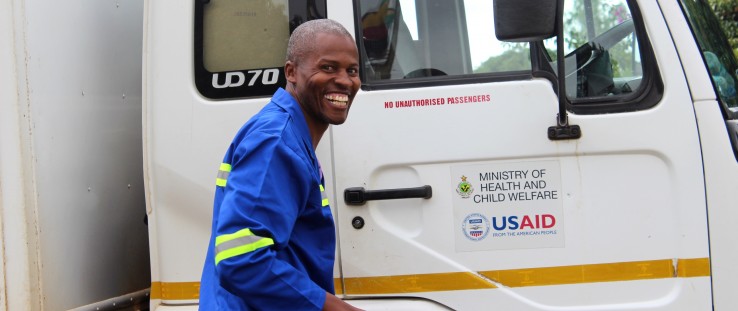 Tinashe Chamahwinya has worked for a USAID partner for over eight years making deliveries to health facilities across Zimbabwe.
Doreen Hove, USAID
Tinashe Chamahwinya has worked for a USAID partner for over eight years making deliveries to health facilities across Zimbabwe.
Doreen Hove, USAID
 Tinashe Chamahwinya has worked for a USAID partner for over eight years making deliveries to health facilities across Zimbabwe.
Doreen Hove, USAID
Tinashe Chamahwinya has worked for a USAID partner for over eight years making deliveries to health facilities across Zimbabwe.
Doreen Hove, USAID
It is the rainy season in Zimbabwe. Although this day is misty with light rain, Tinashe Chamahwinya is driving a huge 90-ton white delivery truck filled with life-saving medicines and medical supplies.
He is on his way to hard-to-reach, rural clinics. His goal is to make deliveries to four clinics today in Hwedza district, located on the eastern side of the country. Chamahwinya has already made similar stops at more than 100 clinics in the last 25 days. Almost 20 delivery trucks are on the road each day delivering medicines and medical supplies to clinics in different parts of the country.
Next up is the Mukamba clinic, which serves nearly 7,000 people. This is the second delivery of the day for Chamahwinya and the rest of his team.
“We deliver these medicines and medical supplies once every three months and give the clinics six months’ supply to avoid stockouts, or clinics running out of supplies,” Chamahwinya says. “Today we are distributing condoms, antiretroviral (ARV) drugs, HIV test kits, CD4 count point of care cartridges (used in technologies that monitor HIV viral loads), syphilis test kits and early infant HIV diagnosis test kits.”
“At times we travel up to 700 kilometers to ensure that people in hard-to-reach communities get access to medicines that prevent and treat HIV and malaria,” Chamahwinya says. When the day is over, they sleep at their final delivery medical facility to avoid running behind schedule.
For over eight years, Chamahwinya has been working for a USAID/Zimbabwe partner, making deliveries to over 1,500 health facilities across the country. Though his role is arguably the most visible, he is part of a remarkable chain of actors, delivering life-saving medicines to Zimbabweans.
A Dire Situation
Fourteen years ago, when USAID first began this work, and as far back as the 1980s, thousands of people were dying every week in Zimbabwe from AIDS, and a significant majority of patients in hospitals were AIDS patients. The only care offered at the time was HIV testing, condoms to reduce new infections and education on positive living.
The Mukamba clinic was like many others in the country facing the HIV epidemic, making little progress, and seeing one AIDS-related death after another. According to UNAIDS, AIDS-related deaths in Zimbabwe peaked during 2000-2003; an estimated 120,000 people died annually over this period.
Viola Chisadza has been a nurse aid at Mukamba since 1982. She vividly remembers how difficult it was for people living with HIV in the 1980s leading up to late 2003, when USAID started delivering medical supplies to the clinic.
Things changed when USAID/Zimbabwe, working with the Ministry of Health and Child Care, started providing ARVs and established a functioning supply chain management system to deliver these life-saving medicines and other medical supplies to communities.
There is sadness in Chisadza’s eyes as she recalls what it was like before the distribution system kicked off: “ARVs and HIV rapid test kits were not available for patients who came to the clinic. Condoms were also not easily available to them, so people could not protect themselves from the disease. Sadly, too many patients only came to the clinic when they were extremely sick, and at times were carried on wheelbarrows because they could no longer walk.
“Since medicines and even test kits were not found at the nearest clinic, community members who got sick had to travel up to 50 kilometers to the district hospital to get tested. As some could not afford the transport costs, they either went late or they just did not go,” Chisadza said. “Many people died, and HIV-positive mothers gave birth to HIV-positive babies.”
In the midst of this dire situation, David Alt, who served as chief of party for the project over its 14 years and retired earlier this year, recalls the major challenge. “Some medicines and medical supplies—for example, contraceptives and condoms—were available in Zimbabwe’s capital city, Harare, but there was no system in place to help distribute them to different facilities in the country,” he said.
Transporting Medicines, Transporting Life
“We set up a logistics system in 2003 because we wanted to create systems that could distribute medicines to communities. USAID/Zimbabwe worked closely with the Ministry of Health and Child Care, the Global Fund, National AIDS Council, and United Kingdom’s Department for International Development (DFID) to make this happen,” Alt explains. “Over the years, we established a fleet of 43 vehicles to deliver medicines and other medical supplies to help monitor the stocks at hospitals.”
USAID continues to support the ministry’s Directorate of Pharmacy Services’ logistics unit, which, for effective coordination, is based at the National Pharmaceutical Company (NatPharm) in Harare. “USAID, in collaboration with other partners, supported improvements to the medical storage facility, increasing the storage capacity from 3,000 to 6,000 square meters,” says Flora Nancy Sifeku, NatPharm’s managing director.
According to Chisadza, the nurse aid from Mukamba clinic, this intervention changed lives. “When these delivery trucks started to bring free medicines to our clinic, people had access to a wide range of medical supplies that made life less difficult,” she explained. “For example, the HIV rapid test kits enabled them to get their results in 20 minutes instead of traveling 50 kilometers to get tested. In addition, having improved access to ARVs enabled HIV-positive mothers to give birth to HIV-free babies, and it saved many more lives because these life-saving medicines were now right at their doorstep.”
Alt also said the supply chain management system reduced stockout rates at clinics and hospitals from 40 percent to about 5 percent, calling it an achievement that partners “are all very proud of.”
The Beginning of Hope
USAID’s support of the effort continues today.
“USAID supported the first pilot public health sector HIV treatment in Zimbabwe in five hospitals and clinics across the country. Before then, ARVs were only available through the private sector at a prohibitively expensive cost. We began with 500 patients nationwide … while Zimbabwe’s Ministry of Health and Child Care provided antiretroviral treatment to 40,000 Zimbabweans,” says Peter Halpert, who was the director of USAID/Zimbabwe’s Health Office between 1999 and 2014. Halpert recalls that progress was slow during the first few years as it was hard to get people to use the medicines due to stigma and discrimination.
“USAID became the first donor to provide antiretroviral medicines to Zimbabweans,” Halpert says. “Ensuring a continuous supply of HIV commodities such as test kits and medicines was a critical component of the program.”
Alt also remembers how important it was to provide ARVs to Zimbabweans. “This was an important initial step to the beginning of hope for the Zimbabweans living with HIV,” he said.
Alt points out that Zimbabwe became the first country in the world to provide USAID-supported ARVs for treatment on a routine basis; in other countries, they only conducted clinical trials.
“However, when the Zimbabwean dollar collapsed in 2007, the Ministry of Health and Child Care was unable to provide ARVs to the 40,000 they were supporting, because they no longer had the foreign exchange to buy the life-saving ARVs,” Alt said. “USAID stepped in and started providing ARVs to over 40,500 people.” USAID’s support quickly expanded, increasing to over 160,000 each year, and, in 2017, to over 190,000.
“What struck me was that, even if others were skeptical, criticizing USAID for putting people on treatment without guaranteeing a lifetime of uninterrupted supplies, we persisted in our belief that saving lives today is what matters,” says Stephanie Funk, the current mission director in Zimbabwe.
“I am happy that ARVs are now the lifeline to any HIV program, both preventing new infections and saving lives. Although we did not know at the time that ARVs would reduce the incidence of HIV infection, we now know that we were contributing to significant reductions in new HIV infections, while also reducing AIDS-related deaths, and preventing a new generation of orphans,” Funk says.








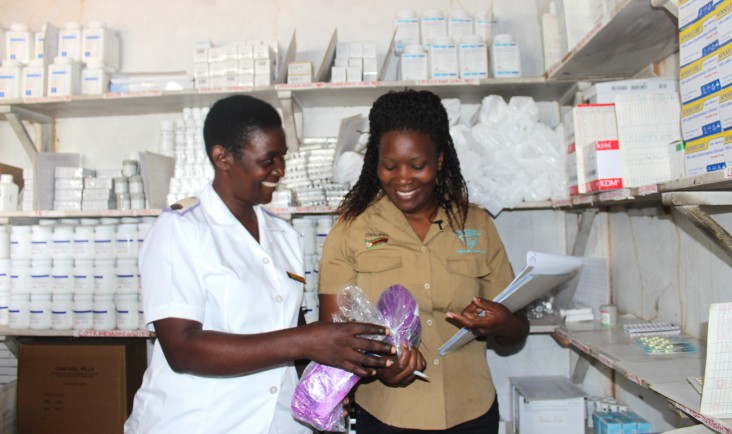
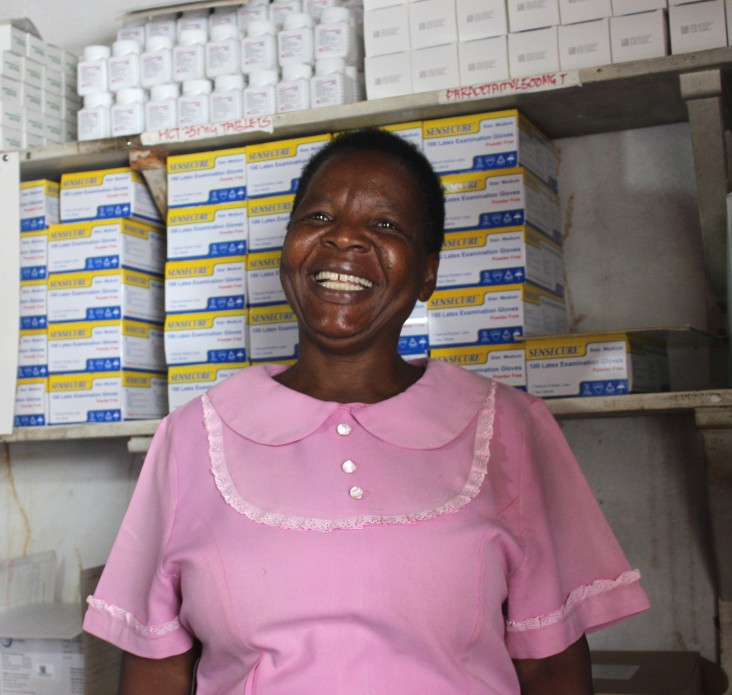
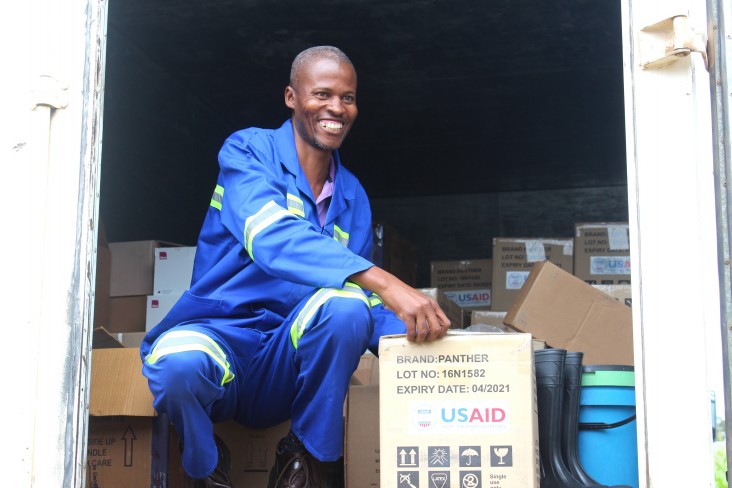
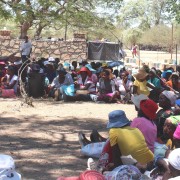
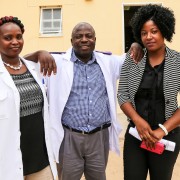
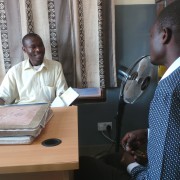
Comment
Make a general inquiry or suggest an improvement.